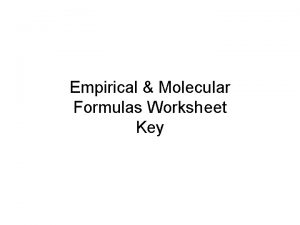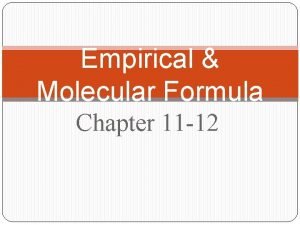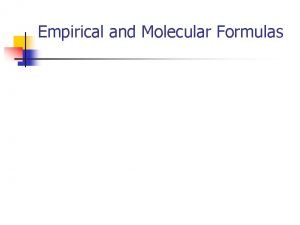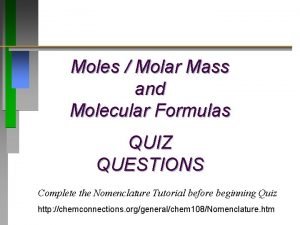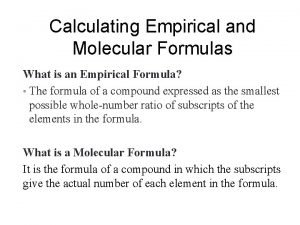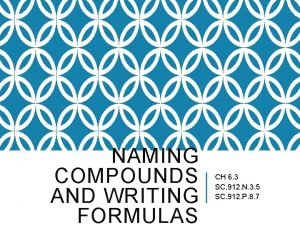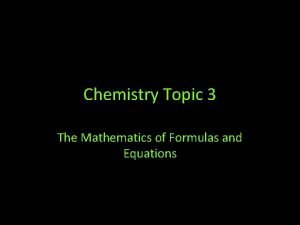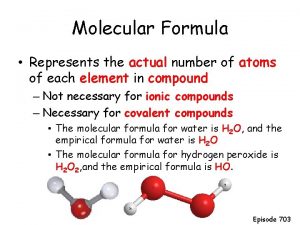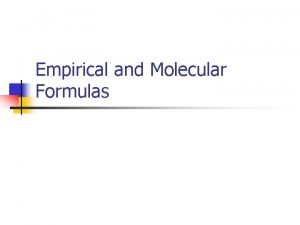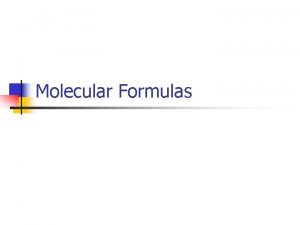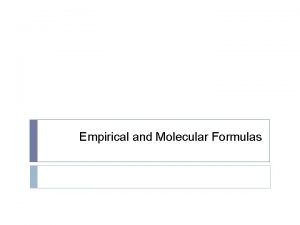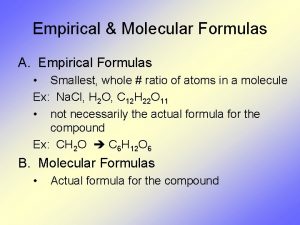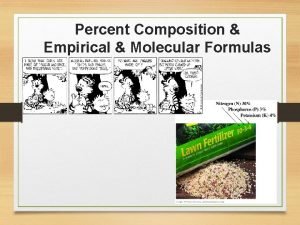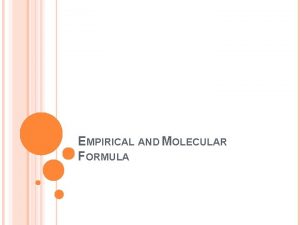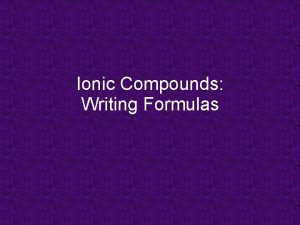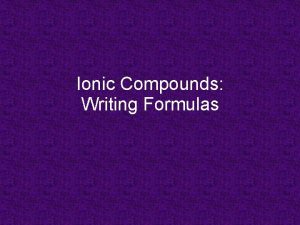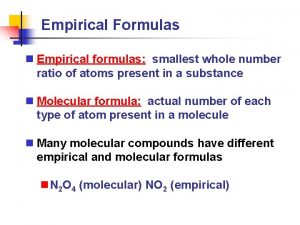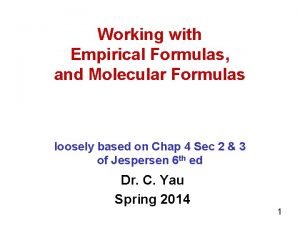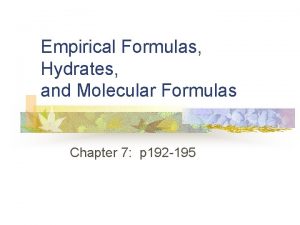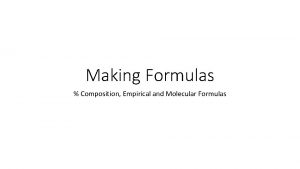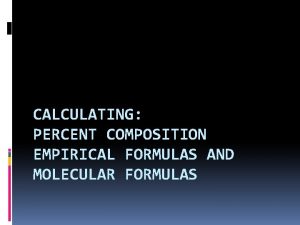Empirical and Molecular Formulas Topic 20 Empirical and



















- Slides: 19

Empirical and Molecular Formulas Topic #20

Empirical and Molecular Formulas • Empirical --The lowest whole number ratio of elements in a compound. • Molecular -- the actual ratio of elements in a compound • Sometimes the two can be the same. • CH 2 empirical formula • C 2 H 4 molecular formula • C 3 H 6 molecular formula • H 2 O both

Calculating Empirical • Just find the lowest whole number ratio • C 6 H 12 O 6 • CH 4 N

Determine the empirical formulas for each of the following molecular formulas. 1. C 8 H 18…. . _______ 2. H 2 O 2……_______ 3. Hg. Cl 2…. . _______ 4. C 3 H 8……. _______ 5. Na 2 C 2 O 4. . . _______ 6. H 2 O. . . ________ 7. C 4 H 8…. . ________ 8. C 4 H 6…. . ________ 9. C 7 H 12…. ________

You can calculate empirical formulas if you know the percent composition………….

Calculating Empirical • • • Pretend that you have a 100 gram sample of the compound. That is, change the % to grams. Convert the grams to mols for each element. Write the number of mols as a subscript in a chemical formula. Divide each number by the least number. Multiply the result to get rid of any fractions.

Example • Calculate the empirical formula of a compound composed of 38. 67 % C, 16. 22 % H, and 45. 11 %N. • Assume 100 g so • 38. 67 g C 1 mol C = 3. 220 mole C 12. 01 g. C • 16. 22 g H 1 mol H = 16. 09 mole H 1. 01 g. H • 45. 11 g N 1 mol N = 3. 219 mole N 14. 01 g. N

• 3. 220 mole C • 16. 09 mole H • 3. 219 mole N • C 3. 22 H 16. 09 N 3. 219 If we divide all of these by the smallest one It will give us the empirical formula

Example • The ratio is 3. 220 mol C = 1 mol C 3. 219 mol. N • The ratio is 16. 09 mol H = 5 mol H 3. 219 mol. N • C 1 H 5 N 1 is the empirical formula • A compound is 43. 64 % P and 56. 36 % O. What is the empirical formula?

• 43. 6 g P 1 mol P = 1. 4 mole P 30. 97 g P • 56. 36 g O 1 mol O = 3. 5 mole O 16 g. O P 1. 4 O 3. 5

Divide both by the lowest one P 1. 4 O 3. 5 • The ratio is 3. 5 mol O = 2. 5 mol O 1. 4 mol P P 1 O 2. 5

• Multiply the result to get rid of any fractions. 2 X P 1 O 2. 5 = P 2 O 5

• Caffeine is 49. 48% C, 5. 15% H, 28. 87% N and 16. 49% O. What is its empirical formula? Empirical Mass=

Empirical to molecular • Since the empirical formula is the lowest ratio the actual molecule would weigh more. • By a whole number multiple. • Divide the actual molar mass by the mass of one mole of the empirical formula.

Caffeine has a molar mass of 194 g. what is its molecular formula? • Find x if 194 g 97 g 2 X C 4 H 5 N 2 O 1 C 8 H 10 N 4 O 2. =2

Example • A compound is known to be composed of 71. 65 % Cl, 24. 27% C and 4. 07% H. Its molar mass is known (from gas density) is known to be 98. 96 g. What is its molecular formula?

Example • A compound is known to be composed of 71. 65 % Cl, 24. 27% C and 4. 07% H. Its molar mass is known (from gas density) is known to be 98. 96 g. What is its molecular formula?

• would give an empirical wt of 48. 5 g/mol Its molar mass is known (from gas density) is known to be 98. 96 g. What is its molecular formula? = =2

1. What’s the empirical formula of a molecule containing 65. 5% carbon, 5. 5% hydrogen, and 29. 0% oxygen? 2. If the molar mass of the compound in problem 1 is 110 grams/mole, what’s the molecular formula? 3. What’s the empirical formula of a molecule containing 18. 7% lithium, 16. 3% carbon, and 65. 0% oxygen? 4. If the molar mass of the compound in problem 3 is 73. 8 grams/mole, what’s the molecular formula?
 Empirical and molecular formula worksheet
Empirical and molecular formula worksheet Empirical and molecular formulas worksheet
Empirical and molecular formulas worksheet Empirical formula from percent composition
Empirical formula from percent composition Empirical formula poem
Empirical formula poem Formula empirik
Formula empirik Empirical formula chemistry
Empirical formula chemistry Empirical formula and molecular formula pogil
Empirical formula and molecular formula pogil Molar mass quiz
Molar mass quiz Molecular formula of ch
Molecular formula of ch Empirical formula and molecular formula
Empirical formula and molecular formula Empirical and molecular formula worksheet doc
Empirical and molecular formula worksheet doc Empirical and molecular formula worksheet doc
Empirical and molecular formula worksheet doc Naming and writing formulas for molecular compounds
Naming and writing formulas for molecular compounds Topic 3 the mathematics of formulas and equations
Topic 3 the mathematics of formulas and equations Physical state of covalent compounds
Physical state of covalent compounds Ionic covalent metallic
Ionic covalent metallic Giant molecular structure vs simple molecular structure
Giant molecular structure vs simple molecular structure Empirical formula vs molecular formula
Empirical formula vs molecular formula Empirical formula from percent composition
Empirical formula from percent composition Empirical formula
Empirical formula
